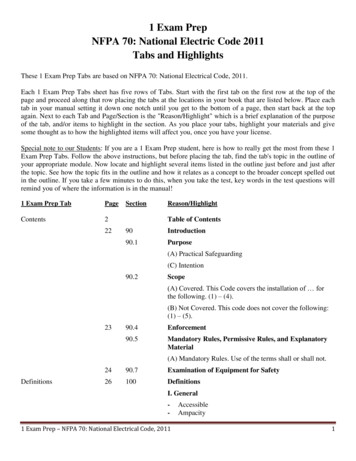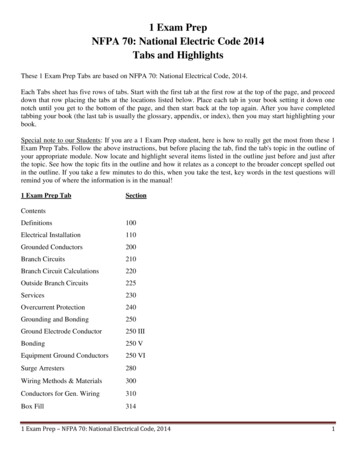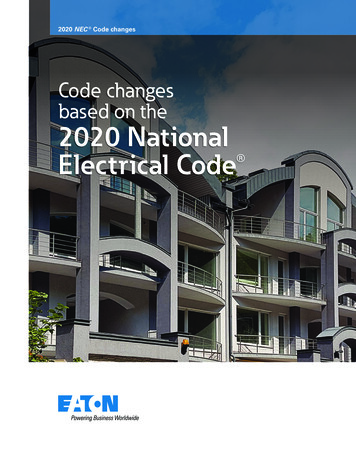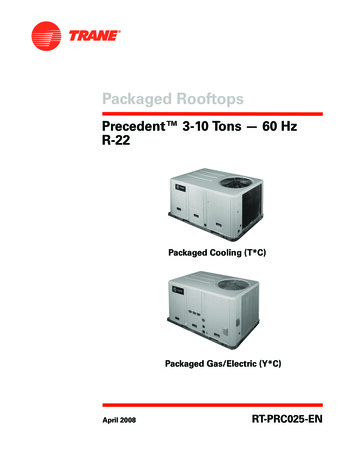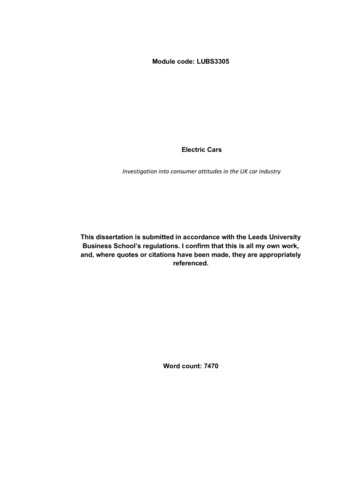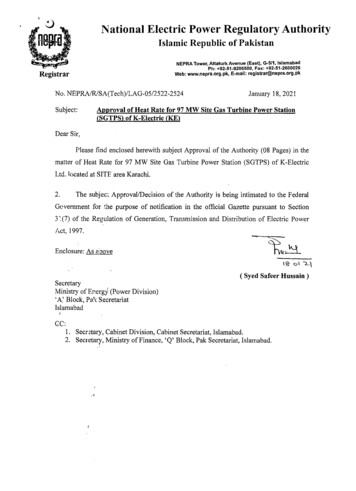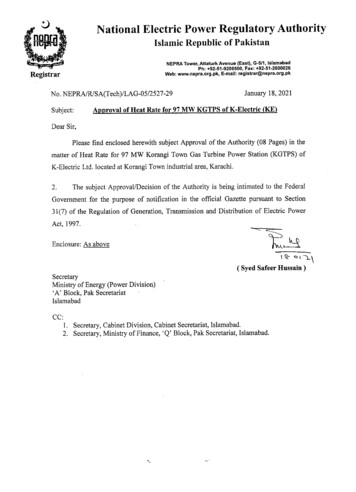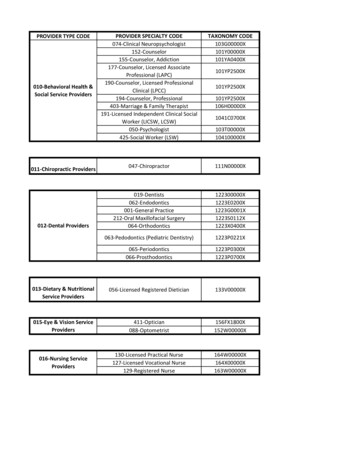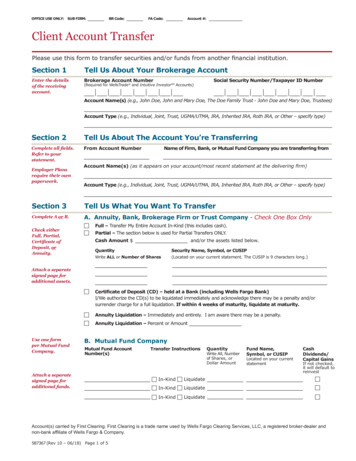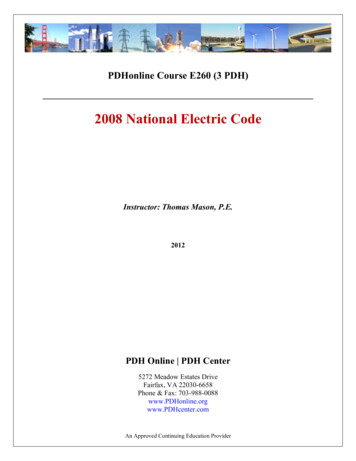
Transcription
PDHonline Course E260 (3 PDH)2008 National Electric CodeInstructor: Thomas Mason, P.E.2012PDH Online PDH Center5272 Meadow Estates DriveFairfax, VA 22030-6658Phone & Fax: 703-988-0088www.PDHonline.orgwww.PDHcenter.comAn Approved Continuing Education Provider
www.PDHcenter.comPDH Course E260www.PDHonline.org2008 National Electric CodeThomas Mason, P.E.Course ContentPreface - The 1896 National Electrical Code was created to reduce the insurance lossesfrom fires of electrical origin.ARTICLE 90, Introduction - The Introduction is a non-enforceable portion of theNational Electric Code (NEC). That means that a Plans Reviewer or Inspector is in errorif he cites you for non-compliance with ARTICLE 90. The Fine Print Notes (FPN) invarious sections are also non-enforceable as are references. Often the NEC referencesother NFPA publications. This information is offered to aid understanding of the sectionbut the portion or document referenced is not enforceable as part of the NEC.The Introduction mentions a goal of the NEC is to “harmonize” with European electricalstandards, IEC publications. (IEC is the International Electrotechnical Commission.)This is good for US manufacturers and designers doing business around the world. Inaddition, it forced NFPA to address issues that are not interesting to US manufacturersand installers, but have safety importance recognized by a “foreign” viewpoint. Forexample, IEC has a very different view on electrician safety and explosion-proofinstallations. These ideas have slowly become part of the NEC and are responsible forseveral of the significant changes in the current edition.SECTION 90 lists areas covered and excluded by the NEC. Beyond being in a nonenforceable Section of the Code, these lists give a directionally incorrect concept. TheNEC is enforced wherever someone in charge chooses to enforce it. Railroads arespecifically excluded, but railroad operating companies can choose to enforce it internallyas an aid in avoiding liability in lawsuits, since the Judge will look at the NEC as arecognized standard of safe installation.Further, the NEC is being revised more broadly each year outside NFPA and within theNFPA committees. For instance, NFPA embraced communications and data wiringseveral editions ago. This means that Plans Reviewers can demand details aboutcommunications and data equipment and planned wiring and hold up the project untilthey get it. Similarly, as Inspectors become more sophisticated, they will be closelyexamining details of communications and data installation. This is a massive change.Communications and data installers come from a different tradition than commercial andindustrial electricians and, in the past, have often paid no attention to fire safety andgrounding rules.The question of “covered by NEC” or “not covered” frequently comes up in defining the“service point”. When you buy electricity from a Utility, at some specific pointresponsibility for installation and maintenance shifts from the Seller to the Buyer. TheNEC has vaguely stated opinions, but the matter is decided by State and local regulationsand by the Utilities policies. It is common for the Utility to specify overhead wiring fromthe street or wiring and underground conduit, and the meter base, but the Owner’s Thomas MasonPage 2 of 43
www.PDHcenter.comPDH Course E260www.PDHonline.orgContractor must install it, subject to Utility inspection. The Utility does the final “hot”tie-in.The message here is that questions regarding the service point should be discussed withthe Utility and the results documented and saved. Experience indicates that differentareas within a single Utility in a single city will have different area supervisors anddifferent enforcement of the rules.Article 100, DefinitionsSometimes we skip over the Definitions section of a document because we are familiarwith the terms used in the field. This is an error with the National Electric Code. TheCode writers have a habit of changing the rules by redefining or adding a term. Forexample there is a critical distinction among “accessible”, “readily accessible(equipment)” and “readily accessible (wiring)”.“Accessible” means not guarded by locked doors or elevation. The concept is that a usershould be able to get at a disconnect switch when a piece of equipment starts smoking. Ifthe only switch or circuit breaker is in a locked closet, there is a problem. As you wouldguess, most Owners of public buildings don’t want the general public turning off thelights or equipment and they lock the electric room. This produces a conflict which issatisfied by normal practice which is not documented in the Code – and varies fromlocation to location. It is almost universal practice to lock the electric room and the Codereferences this in some places. On the other hand, ASHRAE 90.1, enforced by all 50States, requires individual light switches in each area of use. In commercial occupancies,almost all equipment has a wall plug, which can be used for emergency disconnect. Inindustrial occupancies, almost all equipment has a nearby safety disconnect switch.Is “accessible” provided if you need a ladder to get to the device? Yes. That is thedifference between “accessible” and “readily accessible”.For wiring, “accessible” means you don’t have to damage the building to get at theconnections. This is the reason for access panels, junction boxes and surface-mountedand recessed-mounted equipment. Fully-concealed equipment must have some availablescrews to get at the innards. This comes up in renovations when a panelboard is replaced.The old panel box, with the connections for extension, must be left accessible. It is NOTpermissible to make wiring extensions, then mount the new panel on top of the old panelbox.2008 changes to article 100, Definitions, include “equipment” now includes machinery.The NEC is sticking its nose inside the control cabinets in enforcing protection and shortcircuit withstand. This is still part of the voluntary NFPA79, Industrial Machinery, but isnow mandatory.Definitions of grounding conductors have been revised, but are still confusing.“Equipment grounding conductor” means the green wire from the panel to the equipment.“Grounding electrode conductor” means the #6AWG (usually) wire from the servicepanel to the ground rod. (This wiring has expanded substantially in the 2008 Code. Staytuned.) Thomas MasonPage 3 of 43
www.PDHcenter.comPDH Course E260www.PDHonline.org“Qualified person” has been revised to require more training and documentation oftraining for persons working on electrical equipment. This is critical, but very vague asregards to Arc Flash permissible approach limit. The later Arc Flash section limitspermissible locations for persons who do not have documented training in working withexposed electrical conductors. This means operators, supervisors, salesmen andcontractors.The definition for “authority having jurisdiction” (AHJ) hasn’t changed and isn’tconfusing to persons in the electrical trade. It is, however, sometimes confusing tobuilding owners and plant managers. On most commercial and industrial projects, theconstruction documents must be submitted to a city or county building standardsdepartment for approval before a building permit can be issued. The Plans Reviewer atthe building standards department and his Electrical Inspector are the “authority havingjurisdiction”. These persons can make demands for changes in the equipment andmaterials used and the methods used to install them. The “stick” they wave is thebuilding permit and the certificate of occupancy. Sometimes a State official or a militarybase commander has this responsibility. In very, very rare cases, the building owner orplant manager has the responsibility. The Code refers to insurance inspectors havingAHJ responsibility, but this is a contractual relationship, not a legal relationship.Your author is presently suffering significant pain in dealing with a manufacturingfacility that doesn’t want to put lights and receptacles on the roof at HVAC equipmentand ground fault protection on their 2000A, 480Y277V switchboard. When aprofessional engineer places his seal on a set of construction documents, he is certifyingthat it complies with applicable Codes and includes provisions to safeguard the public.The requirement for lights and receptacles at rooftop HVAC equipment comes from theBuilding Code, not the NEC, but the ground fault protection requirement is from 215.10of the NEC.The term “bonding” has been slightly revised and is now well explained in the NECHandbook (a non-enforceable document from NFPA). Bonding means connection ofsomething to ground - something that was not connected to ground previously orsomething that may have been poorly connect to ground previously. The purpose is toprovide a good path to ground for fault current - to trip overcurrent protection or to tripground-fault protection. The information technology (IT) guys are very prominent infacility design and installation these days and many do not understand the requirementsfor grounding and bonding. The new RCDD (registered computer data designer) trainingis helping to improve this situation.The term “enclosure” is defined poorly in the NEC. NEMA-1 means (flimsy) generalpurpose with ventilation holes. It is a violation of NEC to block the ventilation and 6-inof space for air flow may be required by the installation instructions, which are enforcedvia the UL listing and NEC “approved equipment”. NEMA-3R is raintight, listed foroutdoor installation but not limited to outdoor installation. NEMA-4X is dust-tightcorrosion-proof and usually, but not always, heavy-duty. NEMA-12 is dust-tight andusually, but not always, heavy-duty. It is important to specify “heavy-duty”, not just theNEMA rating. NEMA-7 is explosion-proof but should not be used in specifying Thomas MasonPage 4 of 43
www.PDHcenter.comPDH Course E260www.PDHonline.orgequipment. Say, “Class I, Div 2, Group D explosion-proof”. We will discuss the flavorslater, but this is the most common.The term “multi-wire branch circuit” is further developed in the 2008 edition, mostlybecause of new requirements (to be covered later). The example which causes the mosttrouble is two receptacle circuits fed from opposite sides of a 240/120V service. Two hotconductors and a single neutral constitute a multi-wire branch circuit. The newrequirement is for a two-pole circuit breaker to feed the circuit. Similarly, threereceptacle circuits fed from three phases of a 208Y120V. Three hot conductors and asingle neutral constitute a multi-wire branch circuit and require a three-pole circuitbreaker. This shows up often in residential living rooms and daisy-chained commercialreceptacles. It also applies to 208/120V lighting circuits.“Multi-outlet assembly” is a power-pole or power-strip. In schools, it is common to buyrows of moveable computer tables with power-strips. The power strips may be shippedin individual desks or field attached to the row of desks. Even with the 2008 changes,this is not quite legal. Flexible wiring must not be used for permanent installations(400.8) and must not be attached to building surfaces. Use of power-strips in data racksis legal if fed by flexible metal conduit, or equal. (There are special permissions forflexible cables in a properly protected data room, 645.5.) The Code Handbook gives anexample of surface-mounted raceway above a residential kitchen counter; it is commonto use surface-mounted raceway above the bench in shops and labs also. The old-styleschool computer labs with rows of computer along the walls successfully usedpermanently installed surface raceway with both power and data. CAUTION. Spaces for40-persons or more may be classified by the building code as places of assembly andlimit surface raceway to metallic construction only.“Over current” and “overload” are defined in Article 100. The concept is clear - moreamps flowing than the rating for the conductor or device. Interpretations andimplementations muddy the concepts considerably. For conductors, the NEC-rating isnot the manufacturer’s rating. NEC conductor ratings are listed in Table 310.16. Be verycareful to get the right table. Your author recommends using the column for 60C wirebut specify 90C wire. Be warned that there are de-rating requirements for more thanthree current-carrying conductors in a raceway, for above roofs and in spaces above 86F.Also, be warned that the loads being connected for the current project can change andnobody tells you. These are some of the reasons to use 90C wire at its 60C rating. Theseare not reasons to not check on conductor count, location of the runs or load ratings.The definition for “Qualified Person” was mentioned in the earlier discussion of “ArcFlash” It has been revised in the 2008 NEC. This is part of the NFPA effort to regulateconstruction and maintenance. It is not particularly significant as regards design forelectrical construction. It is, rather, another “stick” to use on the Contractor or Owner ifanyone gets hurt, for any reason, during construction or later maintenance. The change inthe 2008 NEC requires explicit safety training. Experience alone is not adequate.Training implies documented training, both as Code compliance and in preparation forfuture lawsuits.“Separately Derived System” is terminology to emphasize grounding in a special class ofequipment. Everything has to be grounded (except gas pipes and some rare special Thomas MasonPage 5 of 43
www.PDHcenter.comPDH Course E260www.PDHonline.orgcases). When you create a new voltage source using a transformer, inverter or generator,the source circuit must be grounded. It is usually a good idea to bond the new source tothe incoming ground from its supply, but the Code requires a building ground andsometimes a water ground. There is controversy on how you ground a diesel- orgasoline- generator, because they are often portable. (They are separately derivedso
2008 National Electric Code 2012 Instructor: Thomas Mason, P.E. PDH Online PDH Center 5272 Meadow Estates Drive Fairfax, VA 22030-6658 Phone & Fax: 703-988-0088 www.PDHonline.org www.PDHcenter.com An Approved Continuing Education Provider. www.PDHcenter.com PDH Course E260 www.PDHonline.org Thomas Mason Page 2 of 43 2008 National Electric Code Thomas
